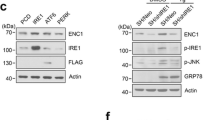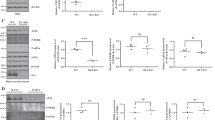Abstract
Neurons are susceptible to different cellular stresses and this vulnerability has been implicated in the pathogenesis of Huntington’s disease (HD). Accumulating evidence suggest that acute or chronic stress, depending on its duration and severity, can cause irreversible cellular damages to HD neurons, which contributes to neurodegeneration. In contrast, how normal and HD neurons respond during the resolution of a cellular stress remain less explored. In this study, we challenged normal and HD cells with a low-level acute ER stress and examined the molecular and cellular responses after stress removal. Using both striatal cell lines and primary neurons, we first showed the temporal activation of p-eIF2α-ATF4-GADD34 pathway in response to the acute ER stress and during recovery between normal and HD cells. HD cells were more vulnerable to cell death during stress recovery and were associated with increased number of apoptotic/necrotic cells and decreased cell proliferation. This is also supported by the Gene Ontology analysis from the RNA-seq data which indicated that “apoptosis-related Biological Processes” were more enriched in HD cells during stress recovery. We further showed that HD cells were defective in restoring global protein synthesis during stress recovery and promoting protein synthesis by an integrated stress response inhibitor, ISRIB, could attenuate cell death in HD cells. Together, these data suggest that normal and HD cells undergo distinct mechanisms of transcriptional reprogramming, leading to different cell fate decisions during the stress recovery.







Similar content being viewed by others
Data Availability
The authors declare that the data supporting the findings of this study are available within the article and its supplementary information files.
References
Andersen JK (2004) Oxidative stress in neurodegeneration: cause or consequence? Nat Med 10(Suppl):S18-25. https://doi.org/10.1038/nrn1434
Atwal RS, Truant R (2008) A stress sensitive ER membrane-association domain in Huntingtin protein defines a potential role for Huntingtin in the regulation of autophagy. Autophagy 4(1):91–93. https://doi.org/10.4161/auto.5201
Buchan JR, Parker R (2009) Eukaryotic stress granules: the ins and outs of translation. Mol Cell 36(6):932–941
Bugallo R, Marlin E, Baltanas A, Toledo E, Ferrero R, Vinueza-Gavilanes R, Larrea L, Arrasate M, Aragon T (2020) Fine tuning of the unfolded protein response by ISRIB improves neuronal survival in a model of amyotrophic lateral sclerosis. Cell Death Dis 11(5):397. https://doi.org/10.1038/s41419-020-2601-2
Chou A, Krukowski K, Jopson T, Zhu PJ, Costa-Mattioli M, Walter P, Rosi S (2017) Inhibition of the integrated stress response reverses cognitive deficits after traumatic brain injury. Proc Natl Acad Sci USA 114(31):E6420–E6426. https://doi.org/10.1073/pnas.1707661114
Culver BP, Savas JN, Park SK, Choi JH, Zheng S, Zeitlin SO, Yates JR, Tanese N (2012) Proteomic analysis of wild-type and mutant huntingtin-associated proteins in mouse brains identifies unique interactions and involvement in protein synthesis. J Biol Chem 287(26):21599–21614. https://doi.org/10.1074/jbc.m112.359307
Eshraghi M, Karunadharma P, Blin J, Shahani N, Ricci E, Michel A, Urban N, Galli N, Rao SR, Sharma M, Florescu K, Subramaniam S (2019) Global ribosome profiling reveals that mutant huntingtin stalls ribosomes and represses protein synthesis independent of fragile X mental retardation protein. BioRxiv. https://doi.org/10.1101/629667
Goodman CA, Hornberger TA (2013) Measuring protein synthesis with SUnSET: a valid alternative to traditional techniques? Exerc Sport Sci Rev 41(2):107–115. https://doi.org/10.1097/JES.0b013e3182798a95
Halliday M, Radford H, Sekine Y, Moreno J, Verity N, Le Quesne J, Ortori CA, Barrett DA, Fromont C, Fischer PM, Harding HP, Ron D, Mallucci GR (2015) Partial restoration of protein synthesis rates by the small molecule ISRIB prevents neurodegeneration without pancreatic toxicity. Cell Death Dis 6(3):e1672–e1672. https://doi.org/10.1038/cddis.2015.49
Hetz C, Zhang K, Kaufman RJ (2020) Mechanisms, regulation and functions of the unfolded protein response. Nat Rev Mol Cell Biol 21(8):421–438. https://doi.org/10.1038/s41580-020-0250-z
Himanen SV, Sistonen L (2019) New insights into transcriptional reprogramming during cellular stress. J Cell Sci 132(21):jcs238402. https://doi.org/10.1242/jcs.238402
Huang N, Erie C, Lu ML, Wei J (2018) Aberrant subcellular localization of SQSTM1/p62 contributes to increased vulnerability to proteotoxic stress recovery in Huntington’s disease. Mol Cell Neurosci 88:43–52. https://doi.org/10.1016/j.mcn.2017.12.005
Jiang Y, Chadwick SR, Lajoie P (2016) Endoplasmic reticulum stress: the cause and solution to Huntington’s disease? Brain Res 1648(Pt B):650–657. https://doi.org/10.1016/j.brainres.2016.03.034
Johri A , Beal MF (2012) Antioxidants in Huntington’s disease. Biochim Biophys Acta 5:664–674. https://doi.org/10.1016/j.bbadis.2011.11.014
Kim YE, Hosp F, Frottin F, Ge H, Mann M, Hayer-Hartl M, Hartl FU (2016) Soluble oligomers of PolyQ-expanded huntingtin target a multiplicity of key cellular factors. Mol Cell 63(6):951–964. https://doi.org/10.1016/j.molcel.2016.07.022
Kouroku Y, Fujita E, Jimbo A, Kikuchi T, Yamagata T, Momoi MY, Kominami E, Kuida K, Sakamaki K, Yonehara S, Momoi T (2002) Polyglutamine aggregates stimulate ER stress signals and caspase-12 activation. Hum Mol Genet 11(13):1505–1515. https://doi.org/10.1093/hmg/11.13.1505
Kumar A, Ratan RR (2016) Oxidative stress and Huntington’s disease: the good, the bad, and the ugly. J Huntingtons Dis 5(3):217–237. https://doi.org/10.3233/JHD-160205
Leitman J, Ulrich Hartl F, Lederkremer GZ (2013) Soluble forms of polyQ-expanded huntingtin rather than large aggregates cause endoplasmic reticulum stress. Nat Commun 4(1):3753. https://doi.org/10.1038/ncomms3753
Leitman J, Barak B, Benyair R, Shenkman M, Ashery U, Hartl FU, Lederkremer GZ (2014) ER stress-induced eIF2-alpha phosphorylation underlies sensitivity of striatal neurons to pathogenic huntingtin. PLoS ONE 9(3):e90803. https://doi.org/10.1371/journal.pone.0090803
Lytton J, Westlin M, Hanley MR (1991) Thapsigargin inhibits the sarcoplasmic or endoplasmic reticulum Ca-ATPase family of calcium pumps. J Biol Chem 266(26):17067–17071
Madabhushi R, Pan L, Tsai LH (2014) DNA damage and its links to neurodegeneration. Neuron 83(2):266–282. https://doi.org/10.1016/j.neuron.2014.06.034
Markmiller S, Soltanieh S, Server KL, Mak R, Jin W, Fang MY, Luo EC, Krach F, Yang D, Sen A, Fulzele A, Wozniak JM, Gonzalez DJ, Kankel MW, Gao FB, Bennett EJ, Lecuyer E, Yeo GW (2018) Context-dependent and disease-specific diversity in protein interactions within stress granules. Cell 172(3):590–604. https://doi.org/10.1016/j.cell.2017.12.032
Niedzielska E, Smaga I, Gawlik M, Moniczewski A, Stankowicz P, Pera J, Filip M (2016) Oxidative stress in neurodegenerative diseases. Mol Neurobiol 53(6):4094–4125. https://doi.org/10.1007/s12035-015-9337-5
Oliveira MM, Lourenco MV, Longo F, Kasica NP, Yang W, Ureta G, Ferreira DDP, Mendonca PHJ, Bernales S, Ma T, De Felice FG, Klann E, Ferreira ST (2021) Correction of eIF2-dependent defects in brain protein synthesis, synaptic plasticity, and memory in mouse models of Alzheimer’s disease. Sci Signal 14(668):5426. https://doi.org/10.1126/scisignal.abc5429
Pakos-Zebrucka K, Koryga I, Mnich K, Ljujic M, Samali A, Gorman AM (2016) The integrated stress response. EMBO Rep 17(10):1374–1395. https://doi.org/10.15252/embr.201642195
Protter DSW, Parker R (2016) Principles and properties of stress granules. Trends Cell Biol 26(9):668–679. https://doi.org/10.1016/j.tcb.2016.05.004
Rabouw HH, Langereis MA, Anand AA, Visser LJ, de Groot RJ, Walter P, van Kuppeveld FJM (2019) Small molecule ISRIB suppresses the integrated stress response within a defined window of activation. Proc Natl Acad Sci USA 116(6):2097–2102. https://doi.org/10.1073/pnas.1815767116
Ratovitski T, Chighladze E, Arbez N, Boronina T, Herbrich S, Cole RN, Ross CA (2012) Huntingtin protein interactions altered by polyglutamine expansion as determined by quantitative proteomic analysis. Cell Cycle 11(10):2006–2021. https://doi.org/10.4161/cc.20423
Ross CA, Poirier MA (2004) Protein aggregation and neurodegenerative disease. Nat Med 10(Suppl):S10-17. https://doi.org/10.1038/nm1066
Schmidt EK, Clavarino G, Ceppi M, Pierre P (2009) SUnSET, a nonradioactive method to monitor protein synthesis. Nat Methods 6(4):275–277. https://doi.org/10.1038/nmeth.1314
Shacham T, Sharma N, Lederkremer GZ (2019) Protein misfolding and ER stress in Huntington’s disease. Front Mol Biosci 6:20. https://doi.org/10.3389/fmolb.2019.00020
Sidrauski C, Acosta-Alvear D, Khoutorsky A, Vedantham P, Hearn BR, Li H, Gamache K, Gallagher CM, Ang KK, Wilson C, Okreglak V, Ashkenazi A, Hann B, Nader K, Arkin MR, Renslo AR, Sonenberg N, Walter P (2013) Pharmacological brake-release of mRNA translation enhances cognitive memory. Elife 2:e00498. https://doi.org/10.7554/eLife.00498
Sidrauski C, McGeachy AM, Ingolia NT, Walter P (2015a) The small molecule ISRIB reverses the effects of eIF2alpha phosphorylation on translation and stress granule assembly. Elife 4:e05033. https://doi.org/10.7554/eLife.05033
Sidrauski C, Tsai JC, Kampmann M, Hearn BR, Vedantham P, Jaishankar P, Sokabe M, Mendez AS, Newton BW, Tang EL, Verschueren E, Johnson JR, Krogan NJ, Fraser CS, Weissman JS, Renslo AR, Walter P (2015b) Pharmacological dimerization and activation of the exchange factor eIF2B antagonizes the integrated stress response. Elife 4:e07314. https://doi.org/10.7554/elife.07314
Smith HL, Freeman OJ, Butcher AJ, Holmqvist S, Humoud I, Schätzl T, Hughes DT, Verity NC, Swinden DP, Hayes J, De Weerd L, Rowitch DH, Franklin RJM, Mallucci GR (2020) Astrocyte unfolded protein response induces a specific reactivity state that causes non-cell-autonomous neuronal degeneration. Neuron 105(5):855-866.e855. https://doi.org/10.1016/j.neuron.2019.12.014
Trettel F, Rigamonti D, Hilditch-Maguire P, Wheeler VC, Sharp AH, Persichetti F, Cattaneo E, MacDonald ME (2000) Dominant phenotypes produced by the HD mutation in STHdh(Q111) striatal cells. Hum Mol Genet 9(19):2799–2809. https://doi.org/10.1093/hmg/9.19.2799
Tsai JC, Miller-Vedam LE, Anand AA, Jaishankar P, Nguyen HC, Renslo AR, Frost A, Walter P (2018) Structure of the nucleotide exchange factor eIF2B reveals mechanism of memory-enhancing molecule. Science 359(6383):eaaq0939. https://doi.org/10.1126/science.aaq0939
Walter P, Ron D (2011) The unfolded protein response: from stress pathway to homeostatic regulation. Science 334(6059):1081–1086. https://doi.org/10.1126/science.1209038
Wheeler JR, Matheny T, Jain S, Abrisch R, Parker R (2016) Distinct stages in stress granule assembly and disassembly. Elife 5:e18413. https://doi.org/10.7554/elife.18413
Wolozin B, Ivanov P (2019) Stress granules and neurodegeneration. Nat Rev Neurosci 20(11):649–666. https://doi.org/10.1038/s41583-019-0222-5
Xiang C, Wang Y, Zhang H, Han F (2017) The role of endoplasmic reticulum stress in neurodegenerative disease. Apoptosis 22(1):1–26. https://doi.org/10.1007/s10495-016-1296-4
Yerbury JJ, Ooi L, Dillin A, Saunders DN, Hatters DM, Beart PM, Cashman NR, Wilson MR, Ecroyd H (2016) Walking the tightrope: proteostasis and neurodegenerative disease. J Neurochem 137(4):489–505. https://doi.org/10.1111/jnc.13575
Zyryanova AF, Weis F, Faille A, Alard AA, Crespillo-Casado A, Sekine Y, Harding HP, Allen F, Parts L, Fromont C, Fischer PM, Warren AJ, Ron D (2018) Binding of ISRIB reveals a regulatory site in the nucleotide exchange factor eIF2B. Science 359(6383):1533–1536. https://doi.org/10.1126/science.aar5129
Funding
This work was supported by the National Institutes of Health (NS111202 to J.W.) and Florida Department of Health (9AZ06 to J.W.). J.W. was partially supported by the National Institutes of Health (EB025819).
Author information
Authors and Affiliations
Contributions
HX performed immunostaining, Western blot and proliferation assay. JB and HX prepared the RNA samples for RNA-seq. EC and JW performed the RNA-seq data analysis. JW and MLL planned the experiment, analyzed the data and drafted the first manuscript. All authors read and approved the final manuscript.
Corresponding author
Ethics declarations
Conflict of interest
The authors declare that they have no conflict of interest.
Ethical Approval
Mice were handled in accordance with the animal protocol approved by the Institutional Animal Care and Use Committees (IACUC) at Florida Atlantic University. All applicable international, national, and/or institutional guidelines for the care and use of animals were followed.
Additional information
Publisher's Note
Springer Nature remains neutral with regard to jurisdictional claims in published maps and institutional affiliations.
Supplementary Information
Below is the link to the electronic supplementary material.
10571_2021_1137_MOESM1_ESM.tif
Supplementary file1 Supplementary Fig. S1. A. Quantitative densitometry analysis of total eIF2α levels normalized to actin during stress (N=3-7 samples per group). B. 100 nM Tg treatment for 30min did not lead to ATF6 cleavage as analyzed by Western blot. C. Quantitative RT-PCR analysis showed that 100 nM Tg treatment did not induce XBP1 mRNA splicing. N=5-6 samples per group. One-way ANOVA with Tukey post hoc analysis. D. Quantitative densitometry analysis of total eIF2α levels normalized to actin during stress recovery (N=3-8 samples per group). (TIF 11123 kb)
10571_2021_1137_MOESM2_ESM.tif
Supplementary file2 Supplementary Fig. S2. Nuclear localization of ATF4 was increased during stress recovery in both STHdhQ7 and Q111 cells. Scale bar: 10 μm. (TIF 13083 kb)
10571_2021_1137_MOESM3_ESM.tif
Supplementary file3 Supplementary Fig. S3. ISRIB attenuated Tg-induced SG formation in STHdhQ111 cells. Representative confocal images showing SG formation under Tg treatment in the absence (A) or presence (B) of ISRIB. Nuclei were counterstained with DAPI. Scale bar 20 μm. (TIF 36179 kb)
Rights and permissions
About this article
Cite this article
Xu, H., Bensalel, J., Capobianco, E. et al. Impaired Restoration of Global Protein Synthesis Contributes to Increased Vulnerability to Acute ER Stress Recovery in Huntington’s Disease. Cell Mol Neurobiol 42, 2757–2771 (2022). https://doi.org/10.1007/s10571-021-01137-9
Received:
Accepted:
Published:
Issue Date:
DOI: https://doi.org/10.1007/s10571-021-01137-9




